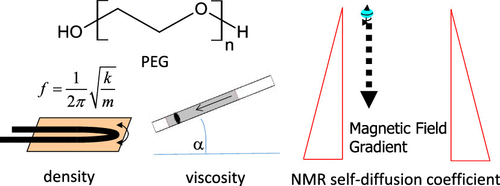当前位置:
X-MOL 学术
›
J. Chem. Eng. Data
›
论文详情
Our official English website, www.x-mol.net, welcomes your feedback! (Note: you will need to create a separate account there.)
Densities, Viscosities, and Self-Diffusion Coefficients of Several Polyethylene Glycols
Journal of Chemical & Engineering Data ( IF 2.6 ) Pub Date : 2021-12-14 , DOI: 10.1021/acs.jced.1c00759 Markus M. Hoffmann 1 , Joseph D. Kealy 1 , Torsten Gutmann 2 , Gerd Buntkowsky 2
Journal of Chemical & Engineering Data ( IF 2.6 ) Pub Date : 2021-12-14 , DOI: 10.1021/acs.jced.1c00759 Markus M. Hoffmann 1 , Joseph D. Kealy 1 , Torsten Gutmann 2 , Gerd Buntkowsky 2
Affiliation

|
Polyethylene glycol (PEG) is increasingly used as an alternative green chemical solvent. New experimental measurements on density, viscosity, and self-diffusion coefficient are presented for PEG200, PEG400, and several binary mixtures of tri- and hexaethylene glycol covering a temperature range from 298.15 to 358.15 K. Because PEGs are polydisperse, the exact compositions of PEG200 from six different vendors are analytically determined and found to be comparable. Thus, only two of the most differing PEG200 samples are further examined. The effects of water as the most common impurity on densities, viscosities, and self-diffusion coefficients are inspected as well as the results of the “dry” samples obtained by extrapolation to zero water content. The obtained results are carefully compared to the available literature data. The temperature dependence of these physical properties is investigated and found to be linear for density, while viscosity and self-diffusion coefficients follow the Arrhenius law. Attempts to calculate the properties of the binary mixtures and PEG200 samples from the mole fraction weighted average of the physical properties of the mixture components result in reasonable agreement. Agreement between calculated and measured molar volumes is within measurement uncertainty. Agreement of calculated and measured viscosities is mostly within a few percent but increases with decreasing temperature (largest viscosities) reaching values of up to 15%. Similarly, calculated and measured self-diffusion coefficients mostly agree within 20%, which is near the measurement uncertainty, but overestimates increase to 30% for the highest temperatures (largest self-diffusion coefficients).
中文翻译:

几种聚乙二醇的密度、粘度和自扩散系数
聚乙二醇 (PEG) 越来越多地用作替代绿色化学溶剂。对 PEG200、PEG400 和几种三乙二醇和六乙二醇二元混合物的密度、粘度和自扩散系数进行了新的实验测量,温度范围为 298.15 至 358.15 K。由于 PEG 是多分散的,因此 PEG200 的确切组成来自六个不同供应商的分析确定并发现具有可比性。因此,只有两个最不同的 PEG200 样品被进一步检查。检查作为最常见杂质的水对密度、粘度和自扩散系数的影响,以及通过外推至零含水量获得的“干”样品的结果。所得结果与现有文献数据进行了仔细比较。研究了这些物理性质的温度依赖性,发现它们与密度呈线性关系,而粘度和自扩散系数遵循阿伦尼乌斯定律。尝试从混合物组分的物理性质的摩尔分数加权平均值计算二元混合物和 PEG200 样品的性质得到了合理的一致性。计算和测量的摩尔体积之间的一致性在测量不确定性范围内。计算和测量粘度的一致性大多在几个百分点内,但随着温度的降低(最大粘度)达到高达 15% 的值而增加。同样,计算和测量的自扩散系数大多一致在 20% 以内,接近测量不确定度,
更新日期:2022-01-13
中文翻译:

几种聚乙二醇的密度、粘度和自扩散系数
聚乙二醇 (PEG) 越来越多地用作替代绿色化学溶剂。对 PEG200、PEG400 和几种三乙二醇和六乙二醇二元混合物的密度、粘度和自扩散系数进行了新的实验测量,温度范围为 298.15 至 358.15 K。由于 PEG 是多分散的,因此 PEG200 的确切组成来自六个不同供应商的分析确定并发现具有可比性。因此,只有两个最不同的 PEG200 样品被进一步检查。检查作为最常见杂质的水对密度、粘度和自扩散系数的影响,以及通过外推至零含水量获得的“干”样品的结果。所得结果与现有文献数据进行了仔细比较。研究了这些物理性质的温度依赖性,发现它们与密度呈线性关系,而粘度和自扩散系数遵循阿伦尼乌斯定律。尝试从混合物组分的物理性质的摩尔分数加权平均值计算二元混合物和 PEG200 样品的性质得到了合理的一致性。计算和测量的摩尔体积之间的一致性在测量不确定性范围内。计算和测量粘度的一致性大多在几个百分点内,但随着温度的降低(最大粘度)达到高达 15% 的值而增加。同样,计算和测量的自扩散系数大多一致在 20% 以内,接近测量不确定度,



























 京公网安备 11010802027423号
京公网安备 11010802027423号